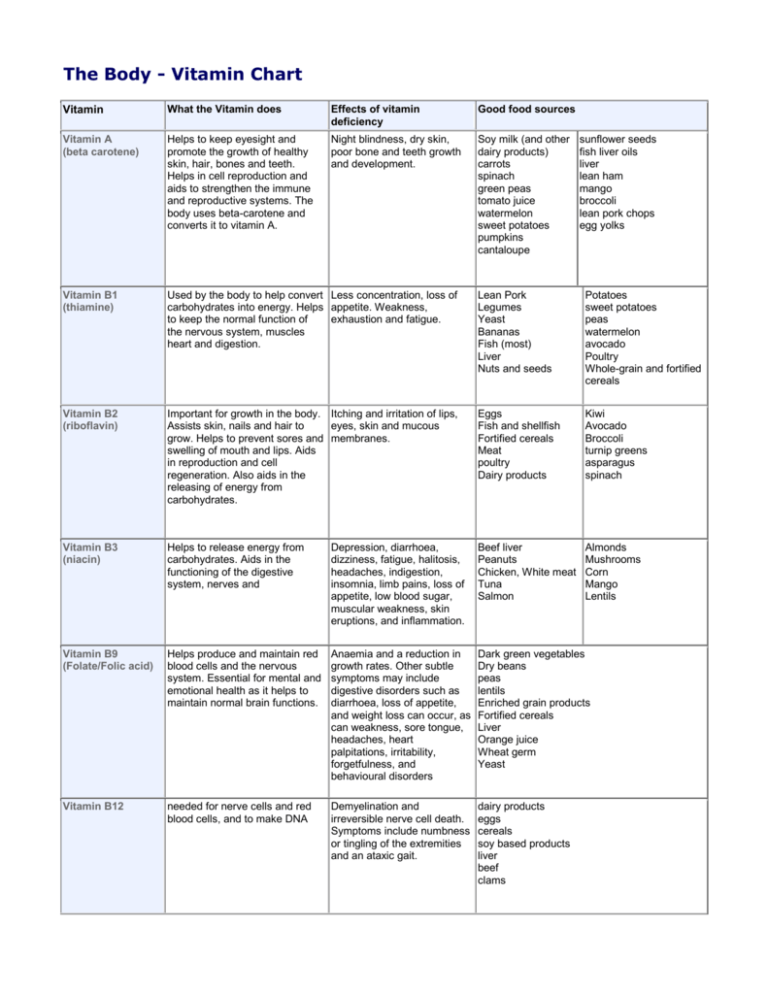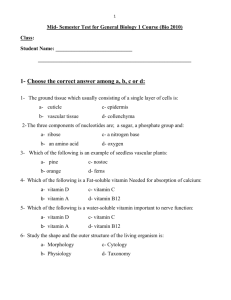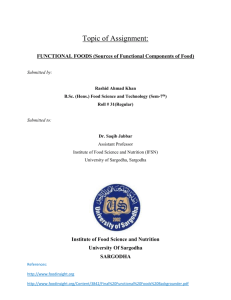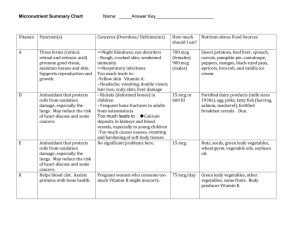File
advertisement

The Body - Vitamin Chart Vitamin What the Vitamin does Effects of vitamin deficiency Good food sources Vitamin A (beta carotene) Helps to keep eyesight and promote the growth of healthy skin, hair, bones and teeth. Helps in cell reproduction and aids to strengthen the immune and reproductive systems. The body uses beta-carotene and converts it to vitamin A. Night blindness, dry skin, poor bone and teeth growth and development. Soy milk (and other dairy products) carrots spinach green peas tomato juice watermelon sweet potatoes pumpkins cantaloupe Vitamin B1 (thiamine) Used by the body to help convert Less concentration, loss of carbohydrates into energy. Helps appetite. Weakness, to keep the normal function of exhaustion and fatigue. the nervous system, muscles heart and digestion. Lean Pork Legumes Yeast Bananas Fish (most) Liver Nuts and seeds Potatoes sweet potatoes peas watermelon avocado Poultry Whole-grain and fortified cereals Vitamin B2 (riboflavin) Important for growth in the body. Itching and irritation of lips, Assists skin, nails and hair to eyes, skin and mucous grow. Helps to prevent sores and membranes. swelling of mouth and lips. Aids in reproduction and cell regeneration. Also aids in the releasing of energy from carbohydrates. Eggs Fish and shellfish Fortified cereals Meat poultry Dairy products Kiwi Avocado Broccoli turnip greens asparagus spinach Vitamin B3 (niacin) Helps to release energy from carbohydrates. Aids in the functioning of the digestive system, nerves and Depression, diarrhoea, dizziness, fatigue, halitosis, headaches, indigestion, insomnia, limb pains, loss of appetite, low blood sugar, muscular weakness, skin eruptions, and inflammation. Beef liver Peanuts Chicken, White meat Tuna Salmon Almonds Mushrooms Corn Mango Lentils Vitamin B9 (Folate/Folic acid) Helps produce and maintain red blood cells and the nervous system. Essential for mental and emotional health as it helps to maintain normal brain functions. Anaemia and a reduction in growth rates. Other subtle symptoms may include digestive disorders such as diarrhoea, loss of appetite, and weight loss can occur, as can weakness, sore tongue, headaches, heart palpitations, irritability, forgetfulness, and behavioural disorders Dark green vegetables Dry beans peas lentils Enriched grain products Fortified cereals Liver Orange juice Wheat germ Yeast Vitamin B12 needed for nerve cells and red blood cells, and to make DNA Demyelination and irreversible nerve cell death. Symptoms include numbness or tingling of the extremities and an ataxic gait. dairy products eggs cereals soy based products liver beef clams sunflower seeds fish liver oils liver lean ham mango broccoli lean pork chops egg yolks Vitamin What the Vitamin does Effects of vitamin deficiency Good food sources Vitamin C (ascorbic acid) Important in the production of collagen in the body - helps the connective tissues and organs. Can act as an anti oxidant to help protect the body from free radical. Scurvy (though rarely seen today) which causes bleeding and inflamed gums, loose teeth and poor wound healing. citrus fruits (oranges, grapefruits, lemons, limes) berries melons tomatoes potatoes green peppers leafy green vegetables Vitamin D Helps to promote the absorption Rickets and osteomalacia. of calcium and phosphorus levels Rickets results in soft bones in the body. Helps to maintain and skeletal deformities and form strong and healthy bones. Liver High-fat fish Fish oils Egg yolk Fortified cereals Fortified milk Sunlight Vitamin E An antioxidant that protects your cells against the effects of free radicals, which are potentially damaging by-products of energy metabolism. Margarine Nuts and seeds Peanuts and peanut butter Vegetable oils Wheat germ Whole-grain and fortified cereals Vitamin K Helps to control blood clotting in A shortage of this vitamin the body and is essential for may result in nosebleeds, synthesizing the liver protein that internal haemorrhaging. controls the clotting Intestinal disorders - cystic fibrosis, pancreatitis, and cholestasis. Prevent the absorption of dietary fats and fat-soluble nutrients. Sources: - Texas heart institute: www.texasheartinstitute.org - American Society for Nutrtional Sciences: www.nutrition.org - www.netdoctor.co.uk Broccoli Brussels sprouts Cabbage Leafy green vegetables Mayonnaise Soybean Canola Olive oils








